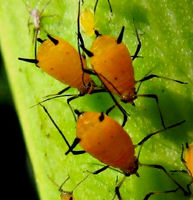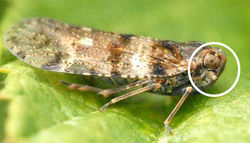Insects of the order Hemiptera (bugs) have piercing and sucking mouthparts and as adults usually 2 pairs of wings. In the superfamily Coccoidea (scales and mealybugs) only the male adults have wings (one pair only) while the females are wingless and sessile. Hemiptera are mostly plant feeders. However, some families are predators (e. g. Reduviidae) and blood-sucking (e. g. Cimicidae).
The name Hemiptera indicates that the forewings (hemi-elytra) are more strongly sclerotized than the hindwings. This is especially developed in the group of the true bugs (Heteroptera). Previously, the Homoptera were regarded as the 2nd group. However, this name is no longer used and instead the group-names Auchenorrhyncha (cicadas, plant- and leaf-hoppers) and Sternorrhyncha (plant lice, scales and mealybugs) should be used. A third group, the Coleorrhyncha (also previously part of the Homoptera), is very small and is found only in the southern hemisphere. Die Auchenorrhyncha are divided into the Cicadomorpha (leaf-hoppers and true cicadas) and the Fulgoromorpha (plant-hoppers). Consequently, the Hemiptera can be divided into 5 suborders: Heteroptera, Sternorrhyncha, Cicadomorpha, Fulgoromorpha and Coleorrhyncha.
Please note that a very useful illustrated on-line key has been provided by Murray J. Fletcher for the Superfamilies of Auchenorrhyncha.
Key to the suborders of the Hemiptera
| 1 | |
| | | | | | | | | a: Proboscis inserted at the tip of the head; wings flatly folded over the abdomen; forewings often divided into a basal, strongly sclerotized part and an apical, membranous part | b: Proboscis inserted at the underside of the head, forewings often positioned roof-like and not divided into a sclerotized and a membranous part (or wingless) | | | | | | | | ▼ | ▼ | | | | | | | true bugs
Heteroptera | 2 | | | | | | |
|
| 2 | |
| | | | | | | | | a: usually sessile colonies on plants, frequently wingless; proboscis appears to originate from the thorax at the base of the forelegs; antennae not ending in a thin, terminal thread; tarsi with 1or 2 segments | b: mobile species, often able to jump very well; proboscis clearly originates from the head; antennae very short with a thin, terminal thread-like portion (arista); tarsi with 3 segments (Auchenorrhyncha - cicadas, plant- and leaf-hoppers) | | | | | | | | ▼ | ▼ | | | | | | | | 3 | 4 | | | | | | |
|
| 3 | |
| | | | | | | | | a: antennae usually with many segments, pronotum and forewings not shield-like, frequently wingless | b: antennae short and 3 segmented, concealed beneath the head, habitus tingid-like (few species, only found in the southern hemisphere) | | | | | | | | ▼ | ▼ | | | | | | | plant lice, scales and mealybugs
Sternorrhyncha | moss bugs
Coleorrhyncha (Peloridiidae) | | | | | | |
|
| 4 | |
| | | | | | | | | a: antennae inserted under the eyes | b: antennae inserted between the eyes | | | | | | | | ▼ | ▼ | | | | | | | planthoppers
Fulgoromorpha | leafhoppers and true cicadas
Cicadomorpha | | | | | | |
|










